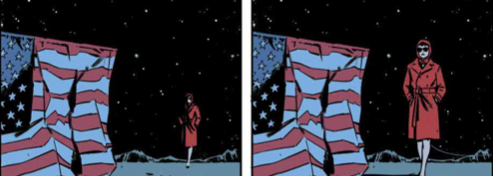Department of Truth #17 // Review
There’s this meeting in the Oval Office between Lee Harvey Oswald, Frank Capra, and Richard Nixon. Nixon is President of the United States as this happens. Don’t think about it too much, and it might sound right. It’s all a matter of believing the right lies in The Department of Truth #17. Writer James Tynion IV is joined by artist Jorge Fornes and colorist Jordie Bellaire in a dramatic little meeting involving one of the most notoriously silly conspiracy theories from the 20th century. While it doesn’t really seem all that interesting on the surface, the creative team actually has a pretty good job of outlining the basic premise of the series.
President Richard Nixon head heard of the Department of Truth. He knew that he would enter into rather important discussions with them. He didn’t know the full reality of what the department was and what it did. He didn’t know what to expect when meeting with Lee Harvey Oswald end, a famous film Director. What he learned there would change the 20th century. Three prominent historical figures have a conversation that might have never happened, Discussing things that might have never been.
Tynion Doesn’t remark a good job of crystallizing the entire idea of his series in a narrative that also features its origin. Theoretically, this would be a good place for people to start reading if they were unfamiliar with the series. In fact, it might be a good place for people to start and gradually work their way through back issues at random doesn’t remark a good job of crystallizing the entire idea of his series in a narrative that also features its origin. The chronicle doesn’t necessarily tie in terribly well with the art, but there’s More than enough in the context of the dialogue between the three men to give the seventeenth issue of the series a great deal of appeal.
Fornes and Bellaire Are working with some remarkably iconic images. Lee Harvey Oswald and Richard Nixon and footage of the moon landing. It all comes together with enough of a haze around the edges. Bring a story like this to the page with too much clarity, and it would feel a bit too crisp. A bit too CGI. The haziness with which the story settles into page and panel feels perfectly well executed. The team isn’t trying to treat reach too hard to find some new way to approach these iconic images. That’s what makes the visual reality of this issue works so well.
The nonlinearity of the series seems to be working at its advantage as Tynion’s take Continues towards the end of the first half of its second year. Finally, readers get some sort of a story that may or may not be the actual origin of the organization referred to in the title. This far end, it almost feels like other series starting again but in a completely different direction with a completely different past. And yet there’s nothing in this issue that specifically contradicts anything mentioned in the past. (Not really.) One of the more provocative issues in the series regards One of the more absurd conspiracy theories. It has been pointed out that vastly more resources would’ve been needed to fake the moon landing. It would’ve cost a fortune to do on a soundstage in the late 1960s what it cost relatively little to do on the moon. Despite the silliness, the creative team managed to make it work.










